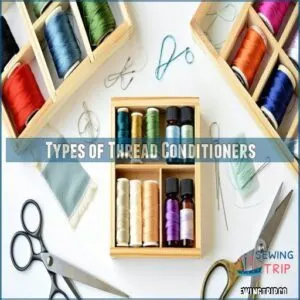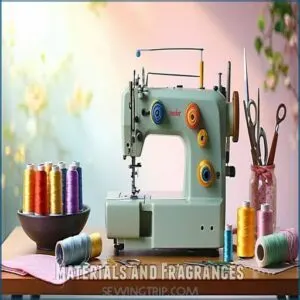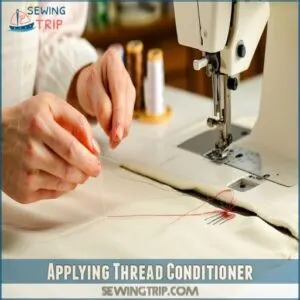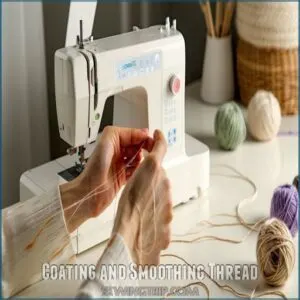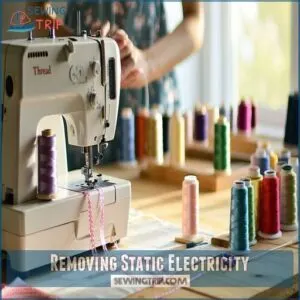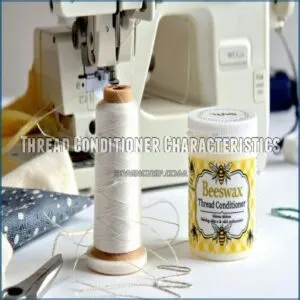This site is supported by our readers. We may earn a commission, at no cost to you, if you purchase through links.
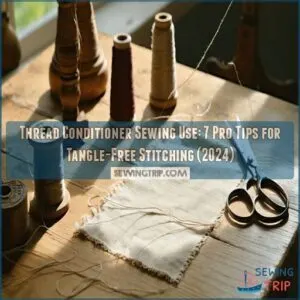 Your thread’s about to become a smooth operator! Thread conditioner sewing use transforms frustrating, tangled messes into perfectly behaved strands.
Your thread’s about to become a smooth operator! Thread conditioner sewing use transforms frustrating, tangled messes into perfectly behaved strands.
Just run your thread across this magical helper before stitching, and you’ll create a protective shield that reduces friction, prevents breaks, and banishes those pesky tangles.
Whether you’re working with delicate silks or tough denims, thread conditioner acts like a tiny superhero, strengthening each fiber while ensuring smooth sailing through your fabric.
You’ll find options from traditional beeswax to modern synthetic formulas, each ready to turn your next sewing adventure into a tangle-free triumph.
Table Of Contents
Key Takeaways
- You’ll prevent thread breakage and tangling by using thread conditioner, which creates a protective coating that reduces friction as your thread moves through fabric.
- You’ve got two main options for conditioners – traditional beeswax provides natural protection while synthetic formulas like Thread Magic offer modern alternatives with added benefits like static reduction.
- You’ll improve your stitch quality with thread conditioner, as it helps maintain consistent thread tension and creates more uniform stitches, especially when working with delicate or challenging fabrics.
- You don’t always need thread conditioner – it’s most useful for hand sewing, binding quilts, needle-turn appliqué, or when you’re working with threads that frequently tangle or break.
Thread Conditioner Benefits
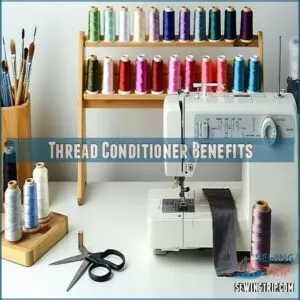
You’ll be amazed at how thread conditioner transforms your sewing experience by preventing those pesky tangles and reducing friction as your thread glides through fabric.
Just like a good hair conditioner keeps your locks smooth and manageable, thread conditioner creates a protective layer that makes your stitching smoother and more enjoyable.
Reducing Friction and Tangling
Thread lubrication’s magic lies in transforming your sewing from a frustrating tangle-fest into smooth sailing.
When you use thread conditioner, you’ll notice four game-changing benefits:
- Threads glide through fabric like butter on a hot pan
- Those pesky knots become a thing of the past
- Your thread stops playing jump rope with itself
- Static cling? Gone faster than free cookies at a craft fair
The secret’s in how it reduces friction, making every stitch flow effortlessly, and this results in a smooth sewing experience.
Preventing Thread Breakage
Beyond taming those pesky tangles, your thread conditioner acts as a superhero shield against thread breakage.
When you’re deep into a project, there’s nothing worse than snapped threads derailing your flow.
The conditioner’s protective coating strengthens each fiber, making your thread more resilient to friction and stress.
You’ll notice markedly fewer breaks, especially when working with delicate threads or handling tough fabrics, thanks to the thread conditioner.
Improving Stitch Quality
Now that you’ve got your thread protected from breakage, let’s boost your stitch quality with thread conditioner. Like giving your thread a spa day, proper conditioning leads to consistently beautiful results.
Here’s what you’ll notice when using thread conditioner for stitch optimization:
- Your thread tension stays perfect, creating uniform stitches that look professionally done
- The sewing thread glides smoothly through fabric, reducing those annoying skips and snags
- Each stitch lies flat and even, especially when working with tricky fabrics, resulting in uniform stitches and beautiful results
Increasing Ease of Use
Your perfect stitches deserve smoother sailing. Thread conditioner transforms your sewing experience by acting like a magic lubricant, making every stitch flow effortlessly.
To achieve superior results, choosing the best thread is vital for minimizing thread breaks and ensuring a professional finish.
You’ll notice immediate improvements in thread management and fabric interaction – no more wrestling with static electricity or stubborn knots. It’s like giving your sewing thread a spa day, resulting in better stitch optimization and overall sewing efficiency that’ll make you wonder how you managed without it.
Choosing Thread Conditioner
You’ll love how a good thread conditioner can transform your sewing experience, from traditional beeswax blocks to modern synthetic options that smell like lavender or vanilla.
Whether you’re hand-stitching a quilt or working on delicate embroidery, picking the right conditioner for your thread type will make your next project smoother than butter on hot toast.
Types of Thread Conditioners
After experiencing those game-changing benefits, let’s explore the different thread conditioner types that’ll transform your sewing game. Think of thread conditioners as your fabric’s best friend – they come in two main categories:
- Natural wax types like beeswax-based thread savers offer traditional, tried-and-true thread coatings
- Synthetic materials featuring silicone-based thread lubricants provide modern protection
- Thread Magic and Thread Heaven create slick fabric interactions
- Traditional conditioner formats include sticks, blocks, and balms
To learn more about the various thread conditioners, such as thread conditioners, choose based on your specific sewing needs – both natural and synthetic options work wonders for different projects.
Materials and Fragrances
Thread conditioners come in two main camps: traditional beeswax and synthetic materials. While pure beeswax offers that classic, natural feel, modern thread lubricants often blend it with paraffin or coconut oil.
To fully appreciate the difference between thread conditioners and traditional methods. Looking for something fun? You’ll find fragrance oils ranging from fruity pear to woodsy cedar.
If you’re sensitive to scents, don’t worry – plenty of unscented options exist for your stitching needs.
Using Thread Conditioner
You’ll love how thread conditioner transforms your tricky threads into smooth, tangle-free champions of stitching.
Just like putting conditioner in your hair makes it more manageable, running your thread through a conditioner before sewing will make your next project a breeze.
Applying Thread Conditioner
Getting your thread conditioner application right makes all the difference in your sewing journey. Before diving into your project, here’s what you need for perfect thread flow: Using a thread conditioner can greatly improve your sewing efficiency.
- Run the thread through your conditioner with gentle, steady pressure (think buttering toast!)
- Hold the conditioner firmly while pulling the thread across its surface
- Keep your fabric prep area clean to avoid any unwanted debris sticking to the conditioned thread
Coating and Smoothing Thread
Now that you’ve got your thread conditioner ready, let’s perfect your coating technique. For ideal thread flow, run your thread through the conditioner with gentle, steady pressure. Think of it like buttering toast – you want even coverage for the best results.
To achieve professional-grade sewing, choosing the best thread is vital for preventing tangles and breakage.
Hold the coated thread between your thumb and index finger, smoothing it down to guarantee fiber protection and consistent friction control.
Removing Static Electricity
The pesky static electricity in your thread can turn a simple sewing project into a tangled mess.
Here’s where thread conditioner becomes your best friend, acting as an effective static reduction method.
You’ll notice a dramatic difference in thread smoothening when you:
- Run the thread through the conditioner twice for better coverage
- Apply gentle pressure while coating
- Test a small section first for friction minimization
- Store your anti-static tools in a dry place
Thread Conditioner Characteristics
You’ll find that thread conditioners work like a superhero’s shield, creating a protective barrier against moisture, dirt, and those pesky UV rays that can damage your thread.
While beeswax leaves a slightly sticky coating that might attract dust, newer synthetic options like Thread Heaven give you a slick, smooth surface that’ll make your thread glide through fabric like butter.
Protective Layer on Thread
Running your thread through conditioner creates an invisible shield of protection, like giving your thread its own suit of armor.
This thread coating defends against moisture, soil, and those pesky UV rays that can weaken fibers over time.
Using a thread conditioner can substantially improve the durability of your stitches.
When you’re working on heirloom pieces or outdoor projects, thread gloss becomes your best friend, offering fiber shielding that keeps your stitches strong and pristine through years of use.
Reducing Static Electricity
Static electricity can turn your peaceful sewing session into a frustrating game of thread chase.
Ever noticed your threads clinging together like they’re best friends? That’s where thread conditioner saves the day.
By coating your threads with anti-static properties, you’ll prevent static buildup and keep those pesky strands from sticking together.
It’s especially helpful when working with synthetic threads that love to create static cling issues.
Beeswax and Synthetic Materials
Now that your thread’s no longer doing the static dance, let’s look at what’s coating it.
Natural beeswax is your thread’s best friend – it strengthens and protects fibers like a charm.
While synthetic alternatives might seem convenient, they often break down over time.
Think of beeswax as your thread’s cozy jacket, keeping it safe through countless stitches, while synthetic materials are more like a temporary raincoat.
For the best sewing thread types, choosing the right material is vital to prevent breakage and guarantee a smooth sewing experience.
Frequently Asked Questions (FAQs)
What is thread conditioner and how is it used?
Like a protective shield for your thread, thread conditioner’s a waxy coating that you’ll run your thread through.
It prevents tangling and makes sewing smoother by reducing friction as you stitch your projects.
What is the best thread conditioner for sewing?
Popular brands like Thread Magic, Sew Fine Thread Gloss, and Ponderosa Thread Gloss work great for your sewing needs.
You’ll get smooth stitching and less tangling with any of these well-rated conditioners.
Do you need a thread conditioner for hand sewing?
While you can hand sew without it, a thread conditioner is worth using to prevent annoying tangles and knots.
It’ll make your thread stronger, smoother, and less likely to fray during stitching.
Should you coat a thread with a ‘conditioner’?
You’ll want to coat your thread if you’re dealing with tangling or fraying issues.
It’s not always necessary, but using a conditioner can make your stitching smoother and prevent frustrating knots.
Do You need A “conditioner” for embroidery?
For most embroidery work, you don’t need a thread conditioner.
It’s really only helpful when you’re working with specialty threads that tangle easily or creating heirloom pieces that require extra protection.
Can you use conditioner on synthetic thread?
Think of synthetic thread like a smooth plastic rope – it won’t absorb conditioner the same way natural fibers do.
You can use conditioner, but it won’t stick well or provide significant benefits.
When to use thread conditioner?
You’ll want to use thread conditioner when hand sewing with natural threads, binding quilts, or doing needle-turn appliqué.
It’s also helpful when your thread keeps tangling or breaking during detailed work.
How to use thread magic conditioner?
Run your thread along the Thread Magic surface, then smooth it between your thumb and finger to remove excess.
It’ll create a protective layer that prevents tangling and makes stitching smoother.
Is thread conditioner just beeswax?
No, thread conditioner isn’t just beeswax.
While beeswax is common, you’ll find modern options made from synthetic materials or silicone-based compounds.
They’re specially designed to protect your thread and make sewing smoother.
What can I use as thread conditioner?
You can use beeswax, specialty thread gloss, or silicone-based products.
For a DIY option, white candle wax works in a pinch.
Each type offers different benefits for smoother stitching and less tangling.
Conclusion
Like a skilled conductor leading an orchestra, proper thread conditioner sewing use transforms your stitching experience.
You’ll notice the difference immediately: smoother threading, fewer snags, and consistently beautiful results.
Whether you choose traditional beeswax or modern synthetic options, you’re investing in your sewing success.
Remember, a well-conditioned thread isn’t just about preventing tangles—it’s about elevating your entire crafting journey.
Take this simple step, and you’ll wonder how you ever sewed without it.

